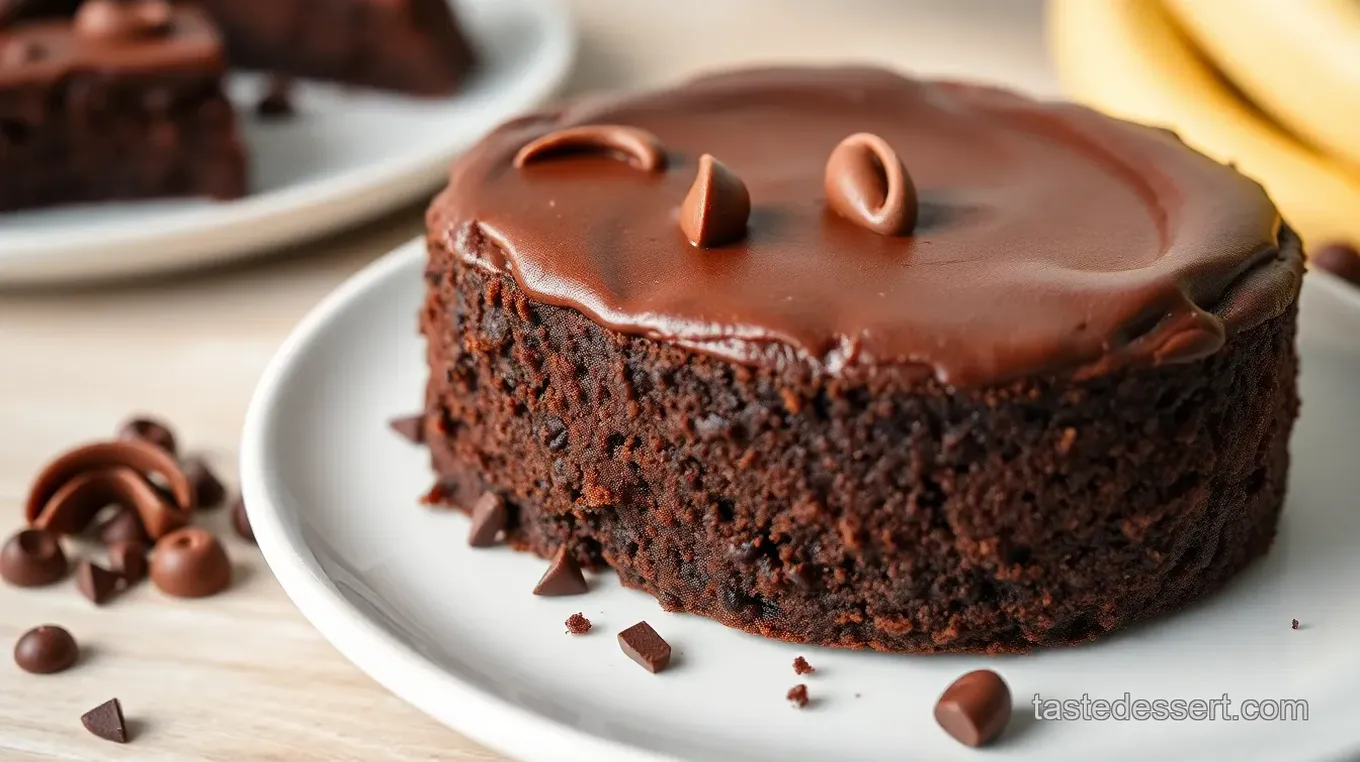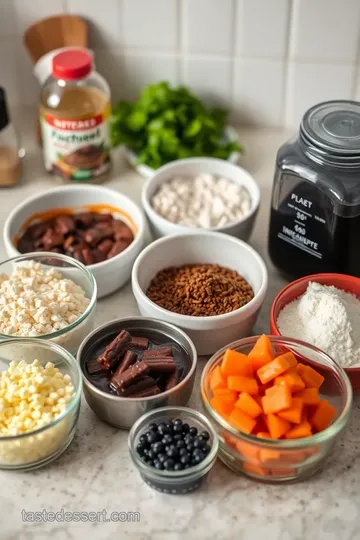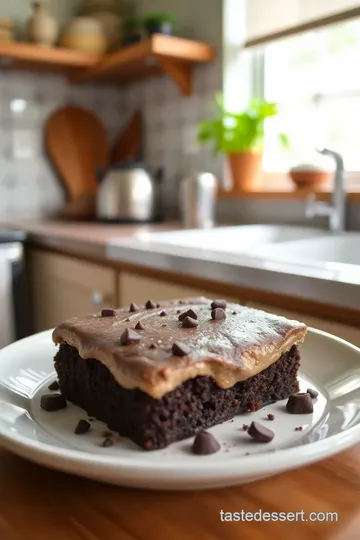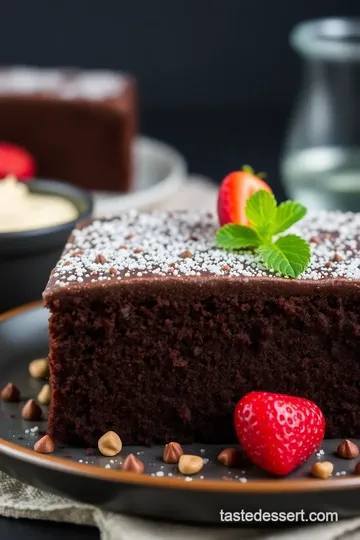Bake Chocolate Cake with Joyful Flavor
Ever wondered how to bake the perfect chocolate cake? Join me in making this delightful chocolate cake with joyful flavor, and learn my secret tips along the way!

A Slice of Joy: The Ultimate Chocolate Cake Experience
Oh my gosh, have you ever baked something that made your whole kitchen smell like a chocolate dream? just the other day, my friends gathered for a little birthday bash, and i decided to bake chocolate cake with joyful flavor .
Honestly, the moment the cake came out of the oven and that rich chocolate aroma filled the air, i could see the excitement on everyone’s faces.
It was like magic!
With layered chocolate cake in mind, I pulled out my family recipes and got to it. Who doesn’t need a good comfort food baking moment, right?
A Little History in Every Bite
Now, let’s dive into the roots of this delightful chocolate cake recipe. chocolate cake has been gracing tables since the late 19th century when cocoa powder became a common ingredient.
Its evolution reflects our growing love for decadent chocolate desserts . today, it’s a classic hit at birthdays and celebrations everywhere.
With its rich textures and layers of flavor , it’s no wonder this cake has become a staple in homes across america.
And it’s not just about comfort; this cake is still super relevant. everyone loves a good chocolate cake recipe that resonates with heart and flavor.
Plus, it doesn’t require a culinary degree to whip it up. did i mention it only takes about 1 hour and 15 minutes to make?
Enjoy the Sweet Benefits
When you think of making a chocolate cake, what comes to mind? to many, it’s a piece of nostalgia. yet, this isn’t just any cake; it comes with a load of health benefits too.
Sure, we’re diving into sugar and calories , but let’s be real—chocolate itself is known for its antioxidant properties! we can all agree that a moist chocolate cake can uplift your mood.
This cake is perfect for special occasions . picture it: a gathering of friends, a celebration of life, and a stunning chocolate ganache frosting that steals the show.
And compared to other desserts, this cake stands out with its unique flavor combinations, solidifying its spot at the center of any party.
Baking Made Simple
So, you’re probably thinking, "how do i get started?" well, the good news is it's a medium-level recipe , making it accessible yet rewarding.
Equip yourself with some kitchen essentials, and you're all set! and hey, if you're new to baking, i’ll share some baking tips and tricks that’ll help you nail it every time.
The key is knowing when to beat those eggs and just how long to leave the cake in the oven.
Avoid common baking mistakes —nobody wants a dry cake, am i right?
Transition to Deliciousness
As we prepare to dive into the ingredients, here’s what you need to know: when you bake chocolate cake with joyful flavor , you’re not just baking a cake.
You’re creating sweet memories, one slice at a time. so grab your mixing bowls, and let’s get ready to bring this joyful dessert to life! it's a recipe straight from my heart, and i can't wait for you to experience it!

Essential Ingredients Guide: Baking the Joyful Chocolate Cake
When we think of baking, the key is all about the ingredients, baby! you want to be sure you're using high-quality stuff to whip up a bake chocolate cake with joyful flavor that’ll knock the socks off your friends and family.
Let’s break down what you need, from the premium core components to those nifty substitutions, and get you ready to conquer that delicious chocolate cake .
Premium Core Components
First off, let's talk measurements, shall we? Here’s a quick rundown of what you need in both US and metric :
- Flour: 1 ¾ cups (220 g)
- Cocoa Powder: ¾ cup (65 g)
- Sugar: 2 cups (400 g)
Now, for quality indicators, go for brands you trust or those marked as premium quality . trust me, using fresh, high-quality cocoa powder and sugar makes a world of difference.
For storage, keep these in a cool, dry place. sugar can last indefinitely, while flour has a shelf life of about six months if stored correctly.
Signature Seasoning Blend
Oh, let’s not forget about those essential spice combinations that can elevate your baking! the secret weapon here is the combination of vanilla and chocolate .
Pure vanilla extract makes everything taste a bit more luxurious! you might also want to stock up on baking powder and soda because, honestly, they help keep your moist chocolate cake fluffy.
Now, if you’re feeling adventurous, consider adding a touch of espresso powder. It enhances the flavor beautifully and brings out the rich chocolate notes in your cake.
Smart Substitutions
Got dietary restrictions in the crew? no problem! here’s where smart substitutions come in. if you need to whip up an eggless chocolate cake , simply swap the two eggs for ½ cup of unsweetened applesauce or ½ cup of yogurt.
For a vegan twist, use almond milk instead of whole milk and a plant-based butter for your ganache.
No cocoa powder? No worries! You can try using Dutch-processed cocoa or even carob powder for a slightly different flavor. The beauty of baking lies in improvisation—so get creative!
Kitchen Equipment Essentials
Alright, my fellow bakers, let’s chat kitchen tools. You’ll need:
- 2 9-inch round cake pans
- Mixing bowls (a large one will do)
- Electric mixer (handheld or stand—just helps save those precious arm muscles)
A rubber spatula is your best friend for mixing and pouring, and parchment paper ensures that cake comes out clean—nobody wants cake stuck to the pan, right? as for storage, keep your flour and baking goods in airtight containers .
This keeps everything fresher longer and ready for your next baking adventure.
Elevating Your Cake Masterpiece
When it comes to baking techniques, there are a couple of key tips. always remember to measure flour correctly ; too much can dry your cake out like the sahara.
Use room temperature eggs and milk to get your batter nice and fluffy, and definitely don’t overbake it. the ultimate chocolate cake has that gooey center we all love, so keep an eye on it during those last few minutes!
Final Thoughts
So there you have it! we’ve chatted about ingredients, storage tips, and even kitchen tools you need to go from amateur to pro in no time.
Now that you're familiar with the essential components for your classic chocolate cake , you’ll be ready to dive into baking.
Next up, we’ll get into the step-by-step instructions for your rich chocolate dessert that’ll be the centerpiece of any gathering—the perfect way to celebrate with joyful desserts.
Are you ready for some sweet, sweet baking experiences? let’s get rolling!
Professional Cooking Method
So, you want to dive into the world of professional cooking? well, buckle up, my friend! let’s break it down step by step, keeping it simple and fun.
Whether you’re trying to bake chocolate cake with joyful flavor or just looking to elevate your cooking game, these pointers will serve you right.
Essential Preparation Steps
First things first, we gotta get organized. when i make a cake or any meal, it’s all about that mise en place .
This french term means “everything in its place.” trust me, having all your ingredients ready to go makes a world of difference.
Measure everything out — flour, sugar, cocoa powder — have them handy! it’s like having an organized toolbox; you don’t want to be hunting for that hammer when it's go-time!
Next up, time management is key. got a timer? use it! seriously, whether you’re roasting vegetables or waiting for that chocolate cake to bake, timing is crucial.
Prepare your ingredients while the oven preheats. this multitasking will keep things running smoothly.
Now let’s talk organization strategies . i like to clean as i go. you know, wash those mixing bowls while the cake is in the oven.
Keeps the chaos manageable. and please — safety first! keep that workspace tidy to avoid any accidents. no one wants to slip on spilled flour.
Ouch!
Step-by-Step Process
Alright, let’s get to the fun part: cooking! Here’s how we roll — think of it like putting together a puzzle.
- Preheat your oven to 350° F ( 175° C) .
- In one bowl, mix your dry ingredients. That’s flour, ¾ cup cocoa powder , sugar, and all the dry stuff.
- Add your wet ingredients: eggs, milk, oil, and vanilla into another bowl. Blend away! You want to mix it for about 2 minutes on medium speed .
- Here’s a cool tip: Stir in 1 cup of boiling water last. Your batter will seem thin, but that’s okay!
- Divide that batter evenly in two 9-inch round cake pans — they should feel like they’re ready to rock!
Bake those beauties for 30- 35 minutes . reminder: check them with a toothpick. if it comes out clean, they’re done! then cool them for about 10 minutes in the pans before moving them to a cooling rack.
Expert Techniques
Want to step up your baking game? let’s dive into some professional techniques. when you frost your cake, go for the chocolate ganache frosting .
Just heat 1 cup of heavy cream until it simmers, pour it over chopped chocolate, and stir in some butter for that glossy finish.
It’s seriously a game changer!
Check the quality checkpoints : your cake should be moist, not dry — aim for that perfect chocolate layer cake.
If it seems dry, maybe you overbaked it? no worries, though; you can always make a quick syrup to moisten the layers.
And if you run into problems, don’t panic! here are some troubleshooting tips: if your cake sinks, it might have been undercooked.
If it’s too crumbly, you may have used too much flour. just remember, learning from these mistakes is part of the journey!
Success Strategies
We all make mistakes, especially in the kitchen, so let’s talk about common ones to dodge. don’t rush your prep meat.
If you cut corners with measuring, you could end up with a dry chocolate cake that has nowhere near the joyful desserts you expected.
Quality assurance is another must-do. Check those ingredients! Use fresh egg and quality cocoa powder. This elevates everything, trust me!
Feeling adventurous? Try some make-ahead options. Bake your chocolate cake layers a day in advance, keep them wrapped, and frost just before serving. It comes together like magic!
Now that you have the essentials down, you’re one step closer to creating your masterpiece. Remember, it's not just about the recipe; it’s about the sweet baking experiences you create along the way!
Oh, and speaking of experiences, don’t forget about Additional Information on troubleshooting tips and how you can take your cakes to the next level. Happy baking!

Bake Chocolate Cake with Joyful Flavor: Your Ultimate Guide
Baking is more than just following a recipe. it’s about creating sweet baking experiences that bring comfort and joy. and trust me, there’s nothing quite like that first slice of a moist chocolate cake , especially when it’s a bake chocolate cake with joyful flavor .
So, let’s dive in, and i’ll share some pro tips, presentation ideas, and variations that will elevate your chocolate cake game like never before!
Pro Tips & Secrets
Alright, let’s spill the beans here. one of my go-to secrets for a delicious chocolate cake is quality ingredients . seriously, don't skimp on that chocolate! for the ganache, i always go for semi-sweet chocolate because it balances perfectly with the sweetness of the cake.
Time-saving tip: while your cake layers are baking, use that time to whip up your chocolate ganache frosting . you can even make it ahead of time and store it in the fridge.
It’s one of those baking tips and tricks that’ll save you from scrambling at the last minute!
Want to bring out even more chocolatey goodness? try adding a pinch of espresso powder to the batter. it really enhances that rich flavor.
Who can resist a rich chocolate dessert that practically sings with flavor?
Perfect Presentation
Once your cake is baked and cooled, it’s time to make it a feast for the eyes. plating techniques can be simple yet effective.
Try layering your cake on a pretty cake stand for that touch of class.
Now, let’s talk garnish. Shave some chocolate on top, or toss on fresh raspberries for a pop of color. Color combinations matter! The deep brown of the cake paired with the vibrant red of berries? Now, that’s Instagram material!
For an extra touch, consider using a drizzle of chocolate ganache over the top. this not only adds to the visual appeal but also ups the indulgence factor.
Trust me, people will be lining up for a slice of this ultimate chocolate cake .
Storage & Make-Ahead
So you’ve baked your cake and it’s a hit—what now? if you need to make it ahead of time, that’s totally doable.
Just wrap the layers in plastic wrap and pop them in the freezer. they’ll last up to three months!
When it’s time to serve, let them thaw in the fridge overnight and frost when they’re nice and cool. if you have leftovers (which is unlikely, but hey, life happens), store your cake in an airtight container.
It typically stays fresh for about 3-4 days on the counter or up to a week in the fridge—just make sure to cover it well!
Creative Variations
Feeling adventurous? go ahead and mix it up with some unique cake variations ! want to switch things up for the season? add pumpkin puree during fall for a festive twist.
Or if you’re going for a lighter dessert, how about trying an eggless chocolate cake recipe?
Oh, and if you or someone you know is vegan, you can swap out the eggs and dairy. There are some amazing vegan chocolate cake alternatives that can still pack a punch in flavor!
Complete Nutrition Guide
And now, for the not-so-fun part—nutrition. But hey, sometimes you just gotta treat yourself! Each serving of this cake is around 350 calories , which isn’t bad for a slice of happiness.
Just be mindful if you have specific dietary needs. Maybe you’re avoiding gluten? There are easy substitutions to make this a simple baking recipe for everyone to enjoy. It's all about balance!
Expert FAQ Solutions
Let’s wrap this up with a few common questions i get asked. a common mistake? many people overbake their cake, thinking it needs extra time.
Trust me, take it out just when a toothpick comes out clean— moist chocolate cake is the goal, not the desert!
Lastly, if your cake doesn’t rise as expected, double-check your baking powder and soda. They can lose potency over time, making your cake come out flatter than expected.
Conclusion
So, if you’re looking for a recipe that brings joy to every bite, bake chocolate cake with joyful flavor is it! with rich flavors, simple baking techniques, and the ability to adapt it to your needs, it’s a winner at any gathering.
Trust me, once you master this cake, your friends and family will be begging you for your classic chocolate cake at every celebration! happy baking, friends!

Bake Chocolate Cake with Joyful Flavor Card

⚖️ Ingredients:
- 1 ¾ cups (220 g) all-purpose flour
- ¾ cup (65 g) unsweetened cocoa powder
- 2 cups (400 g) granulated sugar
- 1 ½ tsp baking powder
- 1 ½ tsp baking soda
- 1 tsp salt
- 2 large eggs
- 1 cup (240 ml) whole milk
- ½ cup (120 ml) vegetable oil
- 2 tsp pure vanilla extract
- 1 cup (240 ml) boiling water
- 1 cup (240 ml) heavy cream
- 8 oz (225 g) semi-sweet chocolate, chopped
- 2 tbsp (30 g) unsalted butter, softened
🥄 Instructions:
- Step 1: Preheat the oven to 350°F (175°C) and prepare the cake pans with parchment paper.
- Step 2: In a large bowl, combine dry ingredients: flour, cocoa powder, sugar, baking powder, baking soda, and salt.
- Step 3: Add eggs, milk, oil, and vanilla to the dry mix; beat with the mixer for 2 minutes on medium speed until smooth.
- Step 4: Carefully stir in boiling water until evenly combined (the batter will be thin).
- Step 5: Divide the batter evenly between the prepared pans.
- Step 6: Bake in preheated oven for 30-35 minutes, until a toothpick inserted in the center comes out clean.
- Step 7: Remove from the oven and cool in pans for 10 minutes, then transfer to a cooling rack to cool completely.
- Step 8: To prepare the ganache, heat cream in a saucepan until simmering, then pour over chopped chocolate in a bowl; let sit for 5 minutes, then stir until smooth, adding butter until melted and glossy.
- Step 9: Once the cakes are cool, spread ganache between the layers and over the top and sides of the cake.
Previous Recipe: How to Make Quick Stir Fry Noodles Colorful Delight: 10 Amazing Tips!
Next Recipe: How to Make the Best Baked Gammon with Sweet Glaze - Easy & Tasty
